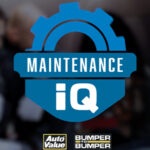So what’s better, a greaseable joint or a sealed joint? That’s a very complex and nuanced argument between the two. For some applications, yes, you want a greaseable joint, but you should not ignore the technology of a sealed joint. These maintenance-free sealed ball joints and tie rod ends came about when the boot material and also how it is sealed to the control arm and ball joint or tie rod end became a lot better, and they were able to go 80, 100,000 miles without any leakage of debris and contaminants into the joint.
But there’s always that application out there that requires a little bit more help. For instance, this ball joint for a Jeep. A Jeep has a relatively tough life. Greasing the joint can extend its life. By pumping greasing into here, you’re pumping out the contaminants inside the joint. You’re also lubricating the joint and making sure it operates properly. But on some vehicles that don’t see as much service, well you may want to go with a sealed joint. Make sure you talk to your counterman on what is better and what is available for the vehicle before you order the part. This way you can understand what are the advantages of a greaseable joint or a sealed joint on a vehicle. I’m Andrew Markel. Thank you very much.
This video is sponsored by Auto Value and Bumper to Bumper.

